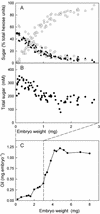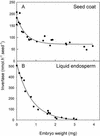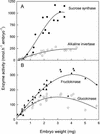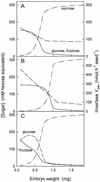Metabolism of sugars in the endosperm of developing seeds of oilseed rape
- PMID: 12529530
- PMCID: PMC166802
- DOI: 10.1104/pp.010868
Metabolism of sugars in the endosperm of developing seeds of oilseed rape
Abstract
The sugars in the endosperm of a developing seed have many potential roles, including the supply of carbon to the developing embryo and controlling gene expression in it. Our understanding of their metabolism is, however, fragmentary and is confined to a very few species (especially Vicia spp.). To develop a quantitative understanding of the regulation of sugars in seeds of oilseed rape (Brassica napus), we measured relevant enzyme activities, the sizes of the pools of sugars in the liquid endosperm, and the flux of sugars from the endosperm into the embryo. The concentrations of hexose sugars in the liquid endosperm decreased, and sucrose (Suc) increased through development. The overall osmotic potential also fell. The timing of the changes was not precise enough to determine whether they signaled the onset of rapid accumulation of storage products. Changes in endosperm invertase activity were complex and quantitatively do not explain the changes in sugars. The embryo can metabolize hexose sugars in addition to Suc, and possibly at higher rates. Therefore, in addition to invertase, the growing embryo itself has a potential to influence the balance of sugars in the endosperm. The activity of Suc synthase in the embryo was greater than that of invertase during development. This observation and a higher activity of fructokinase than glucokinase in the embryo are both consistent with the embryo using Suc as a carbon source.
Figures







References
-
- Appeldorn NJK, Sergeeva L, Vreugdenhil D, van der Plas LHW, Visser R. In situ analysis of enzymes involved in sucrose to hexose-phosphate conversion during stolon-to-tuber transition of potato. Physiol Plant. 2002;115:303–310. - PubMed
-
- Baud S, Boutin J-P, Miquel M, Lepiniec L, Rochat C. An integrated overview of seed development in Arabidopsis thaliana ecotype WS. Plant Physiol Biochem. 2002;40:151–160.
-
- Borisjuk L, Walenta S, Weber H, Mueller-Klieser W, Wobus U. High-resolution histographical mapping of glucose concentrations in developing cotyledons of Vicia faba in relation to mitotic activity and storage processes: glucose as a possible developmental trigger. Plant J. 1998;15:583–591.
-
- Borisjuk L, Wang TL, Rolletscheck H, Wobus U, Weber H. A pea seed mutant affected in the differentiation of the embryonic epidermis is impaired in embryo growth and seed maturation. Development. 2002;129:1595–1607. - PubMed
Publication types
MeSH terms
Substances
LinkOut - more resources
Full Text Sources
Miscellaneous

